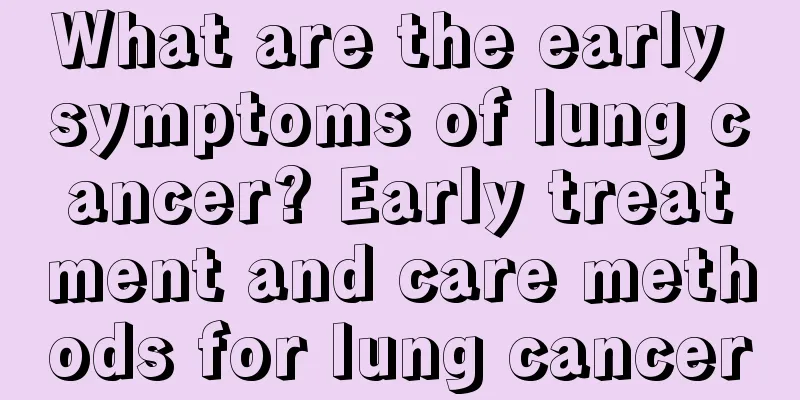What are the early symptoms of lung cancer? Early treatment and care methods for lung cancer

|
Lung cancer is the most common malignant tumor of the lungs. Knowing the early symptoms of lung cancer can help us detect and receive treatment in time, increasing the chances of curing lung cancer. Lung cancer that occurs in the bronchial mucosal epithelium is also called bronchial lung cancer. What we usually call lung cancer refers to malignant tumors from the epithelial cells of the bronchial or bronchiolar epithelium, accounting for 90-95% of malignant tumors of the lung parenchyma. The high-risk population for lung cancer is people over 40 years old, who usually smoke more than one pack a day and have smoked for more than 20 years, especially men. If the following situations occur in this group of people, they should be highly vigilant: 1. Hoarseness This is the most important early feature of lung cancer and also a new discovery explored by experts at home and abroad in recent years. Hoarseness can occur in pharyngitis, colds, and acute bronchitis; after thyroid surgery, pharyngeal surgery; or after improper vocalization, excessive talking, or even heavy smoking and drinking. However, this type of hoarseness can generally be treated symptomatically or healed by rest. Hoarseness caused by lung cancer, thyroid cancer, and laryngeal cancer is completely different from the above types of hoarseness, especially lung cancer. Other early symptoms of lung pain, such as cough, chest pain, hemoptysis, etc., lack characteristic features, while hoarseness has certain specificity. According to statistics, about 20% to 30% of lung cancer patients may experience hoarseness at different stages of the disease, including the early stage, of which central lung cancer may be as high as 40%. The pathology of hoarseness caused by lung cancer is that the tumor invades and compresses the nerves that control the vocal cords. This hoarseness often occurs suddenly, progresses rapidly, and even completely loses the voice. At the same time, most patients are accompanied by chest pain, etc., and rest and anti-inflammatory symptomatic treatment for more than two weeks are still ineffective. 2. Fever When central lung cancer grows in the bronchus and develops to the point where the lumen is semi-obstructed or completely obstructed, obstructive pneumonia may occur. The fever is generally around 38°C and can be easily reduced with anti-inflammatory treatment. However, if the obstructive lesions are not removed, pneumonia will reappear soon, forming recurrent pneumonia. 3. No symptoms About one-third of lung cancer patients have no obvious early symptoms and can only rely on regular examinations to detect the disease early. 4. Coughing up blood This is special in early lung cancer cases. For example, in central lung cancer, coughing up blood often occurs in the early and middle stages of the disease. The amount of blood is not much, and the blood is bright red or mixed with foam. The reason for this phenomenon is that the surface of the tumor is rich in blood vessels. Coughing damages the surface layer, causing blood vessels to rupture. If there is occasional coughing up blood, it often recurs or only lasts for a long period of time. 5. Cough Lung cancer has different symptoms due to its different locations and functional damage. Since tumors mostly grow on large bronchi and are highly irritating, coughing is easy to occur. However, the degree of cough varies. About 50% of patients have irritating coughs, no sputum or a little white foamy sputum. After secondary infection, the quality of sputum also changes. People with chronic coughs should be alert if they find that the nature of their cough is different from usual. Patients of high-risk age should seek medical attention as soon as possible when the cough is ineffective after treatment or lasts for a long time. Those with hemoptysis should seek medical attention earlier. Early symptoms of lung cancer Cough, mostly irritating cough Cough is an early symptom of lung cancer, characterized by paroxysmal irritating cough, a feeling of incomplete coughing, generally no sputum or only a small amount of white foamy sputum, secondary infection may produce purulent sputum. If there is no improvement after 2 weeks of anti-inflammatory treatment, you should be alert to the possibility of lung cancer. Or if the nature of the cough changes on the basis of the original chronic cough, even accompanied by "tracheal tinnitus" and "shortness of breath", you should pay attention. Another warning sign of lung cancer is intermittent and repeated small amounts of bloody sputum, or blood in the sputum. In addition, there are symptoms such as chest and back pain, chest tightness, and fever. Chest tightness and pain, generally mild symptoms, unclear location. When the tumor invades the pleura and chest wall, the pain intensifies and the location is clearer and more constant than before. Shortness of breath, pneumonia caused by cancer obstruction, atelectasis, malignant pleural effusion, diffuse alveolar lesions, etc. can all be caused. ⑤ Fever, caused by obstructive pneumonia or cancer toxins. ⑥ Late-stage patients may develop more obvious cachexia It is recommended that patients with the above symptoms go to the hospital for scientific examination. Lung cancer should be detected and treated early to relieve the pain of the disease as soon as possible. Early treatment of lung cancer The digestive system of patients with early lung cancer is sound. After clinical diagnosis, they should take the time to supplement nutrition to improve physical fitness, enhance resistance, and prevent or delay the occurrence of cachexia. Early detection and early treatment of patients with early lung cancer, combined with traditional Chinese medicine treatment and nutritional supplementation, can complement each other, improve the cure rate, prolong survival, reduce pain, and improve the quality of life for lung cancer patients. Therefore, patients with early and middle stage lung cancer should supplement various nutrients as soon as possible, such as high-quality protein, carbohydrates, fat, inorganic salts and multiple vitamins, under the condition that digestion and absorption capacity allows. In view of the cough and hemoptysis of lung cancer patients, traditional Chinese medicine has many prescriptions and food recipes for nourishing yin and moistening the lungs, relieving cough and stopping bleeding, and astringing. For example, foods that nourish yin and moisten the lungs include almond jellyfish, lily, water chestnut, etc., while lotus root nodes, lotus seeds, persimmons, pears, yam, lily, white fungus, etc. have the effects of relieving cough and astringing and stopping bleeding. According to folk prescriptions, lung cancer patients can also eat foods that nourish yin and nourish, such as gecko, tortoise plaster, turtle meat, and glutinous rice. Choosing traditional Chinese medicine for treatment is a good choice, but traditional Chinese medicine treatment emphasizes diagnosis and treatment. It is best for the patient to be seen by a doctor, who will prescribe the right medicine based on the patient's condition. Chinese medicine is relatively mild and has no side effects, so patients are generally able to accept it. In addition, most cancer patients can generally reduce pain, prolong life, and improve their quality of life by taking Chinese medicine. Compared with digestive tract tumors, the diet of lung cancer patients should be easier to solve. In addition to the above-mentioned nourishing foods of traditional Chinese medicine, lung cancer patients should choose milk, eggs, lean meat, animal liver, soy products, fresh vegetables and fruits, etc. You can try to increase the patient's food intake and frequency of eating. Note: Lung cancer patients should avoid fishy and greasy food, spicy food, tobacco, alcohol and other irritating foods. . Recognize and understand some characteristic symptoms of early lung cancer, study scientific knowledge about lung cancer carefully, and be highly vigilant about the possibility of lung cancer. Patients with early lung cancer should strengthen their health care with traditional Chinese medicine and seek medical treatment in time to avoid delaying the disease. How to care for early lung cancer Lung cancer is a very common cancer, ranking second in the mortality rate of malignant tumors in my country. Generally, the systemic symptoms of lung cancer are not obvious. In the early stage, there may be symptoms similar to tuberculosis, such as cough, shortness of breath, blood in sputum, etc. In the late stage, patients may have fever, weight loss, fatigue, and even cachexia. ! The digestive system of patients with early and middle stage lung cancer is sound. Before and after treatment, they should take the time to supplement nutrition to improve physical fitness, enhance resistance, and prevent or delay the occurrence of cachexia. If nutrients are fully supplemented before treatment, patients with better physical condition will have a stronger tolerance to chemotherapy and radiotherapy, and the treatment effect will be better; similarly, patients with better physical condition are more receptive to surgical treatment and can recover faster than patients with poor nutritional status. Therefore, patients with early and middle stage lung cancer should supplement various nutrients as soon as possible, such as high-quality protein, carbohydrates, fats, inorganic salts and multiple vitamins, under the condition that digestion and absorption capacity allows. In view of the cough and hemoptysis of lung cancer patients, traditional Chinese medicine has many prescriptions and food recipes for nourishing yin and moistening the lungs, relieving cough and stopping bleeding, and astringing. For example, foods that nourish yin and moisten the lungs include almond jellyfish, lily, water chestnut, etc., while lotus root nodes, lotus seeds, persimmons, pears, yam, lily, white fungus, etc. have the effects of relieving cough and astringing and stopping bleeding. According to folk prescriptions, lung cancer patients can also eat foods that nourish yin and nourish, such as gecko, tortoise plaster, turtle meat, and glutinous rice. Compared with digestive tract tumors, the diet of lung cancer patients should be easier to solve. In addition to the above-mentioned nourishing foods of traditional Chinese medicine, lung cancer patients should choose milk, eggs, lean meat, animal liver, soy products, fresh vegetables and fruits, etc. to increase the patient's food intake and frequency of eating as much as possible. Note: Lung cancer patients should avoid fishy and greasy food, spicy food, tobacco, alcohol and other irritating foods. The above introduces the early symptoms, early treatment and early care of lung cancer. Protecting your health starts from the early stage! Special reminder: smoking is the most common example of lung cancer, so please give up smoking. |
>>: How to diagnose primary lung cancer? Diagnostic methods for early primary lung cancer
Recommend
What antibiotics to take for pharyngitis, the best choice is the one with less side effects
Pharyngitis is not a serious disease, but it has ...
What are the effects of lumbar traction?
There are many reasons for lumbar disc herniation...
Rapid reduction of eyelid edema
Many people have swollen eyelids when they wake u...
How to treat tracheitis dry cough?
Nowadays, many patients suffer from bronchitis, a...
How to prevent lung cancer in daily life? Lung cancer prevention should start from four aspects
In recent years, lung cancer has become a common ...
What methods are generally used to treat liver cancer? A review of the top ten treatment methods for liver cancer
1. Surgical treatment Surgical resection is still...
There is a piece of flesh growing behind the teeth
Generally, when a piece of flesh grows behind a t...
What causes fallopian tube pain?
The fallopian tubes are on both sides of the uter...
What are the Chinese medicinal herbs for rheumatism
Rheumatic bone pain seriously affects the patient...
Recovery exercise methods after meniscus injury surgery
I believe that friends who like to play basketbal...
How to squeeze blackheads after nose surgery
In the eyes of many people, the nose is the most ...
How to treat idiopathic thrombocytopenic purpura
Idiopathic thrombocytopenic purpura is a clinical...
Who are the people who are prone to colon cancer? These 3 types of people must pay attention
People who are susceptible to colon cancer includ...
What are the symptoms of rabies?
Rabies does not necessarily occur after being bit...
What to do after gallbladder cancer metastasizes to the liver?
What should we do after gallbladder cancer metast...









